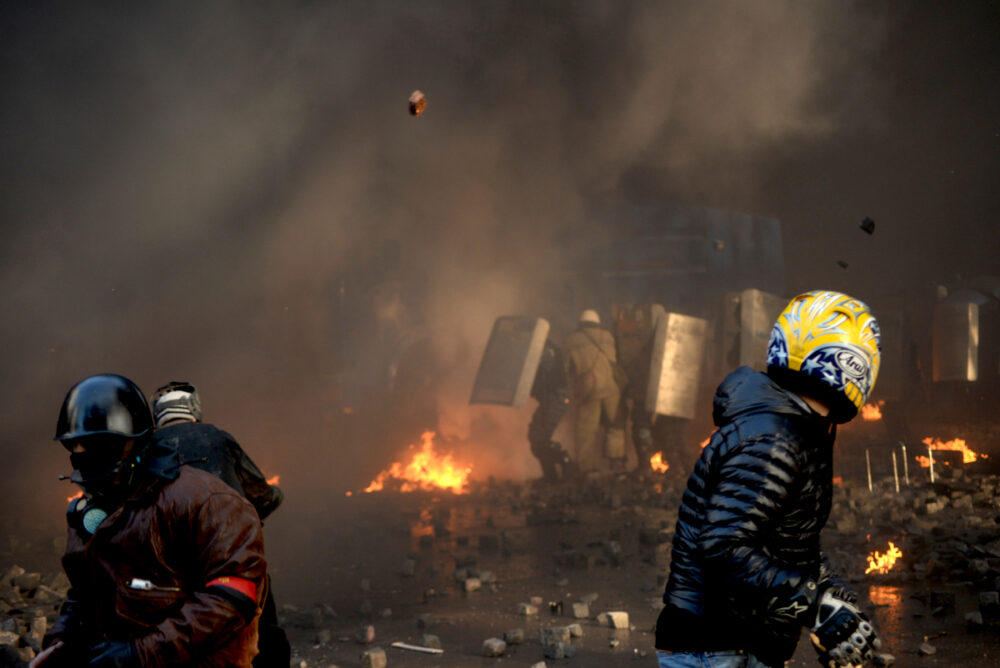Reprinted from Consortium News.
As U.S. House members grapple with whether to give $60 billion more to Ukraine, they must also grapple with the checkered nature of the intelligence they’ve been fed.
On July 13, 2023, President Joe Biden announced Russian President Vladimir Putin “has already lost the war.” That was six days after C.I.A. Director William Burns, normally a sane voice, had called the war a “strategic failure” for Russia with its “military weaknesses laid bare.”
Earlier, in December 2022, National Intelligence Director Avril Haines reported that the Russians were experiencing “shortages of ammunition” and were “not capable of indigenously producing what they are expending.”
We advise caution, as these same people now say that Ukraine can prevail if the U.S. provides $60 billion more. Do they think they can change geography, overcome Russian industrial might, and persuade the Russians that Ukraine should not be a core interest of theirs?
Obama’s Reasons
Recall President Barack Obama’s reasons for withholding lethal weapons from Ukraine. In 2015, The New York Times reported on Obama’s reluctance: “In part, he has told aides and visitors that arming the Ukrainians would encourage the notion that they could actually defeat the far more powerful Russians, and so it would potentially draw a more forceful response from Moscow.”
Senior State Department officials spelled out this rationale:
“If you’re playing on the military terrain in Ukraine, you’re playing to Russia’s strength, because Russia is right next door. It has a huge amount of military equipment and military force right on the border. Anything we did as countries in terms of military support for Ukraine is likely to be matched and then doubled and tripled and quadrupled by Russia.”
The above words were spoken by then-Deputy Secretary of State Antony Blinken on March 5, 2015 to an audience in Berlin. It turns out President Obama was right. It is hard to understand why Blinken (and Biden) chose the way of President Donald Trump, who gave lethal weapons to Ukraine, over the way of Obama.
So much for geography and relative strength. What about core interests? In 2016 President Obama told The Atlantic that Ukraine is a core interest of Russia but not of the U.S. He warned that Russia has escalatory dominance there: “We have to be very clear about what our core interests are and what we are willing to go to war for.”
Earlier, when a saner William Burns was ambassador to Russia, he warned of Moscow’s “emotional and neuralgic reaction” to bringing Ukraine into NATO. Braced on the issue by Foreign Minister Sergei Lavrov in February 2008, Burns reported that Russia’s opposition was based on “strategic concerns about the impact on Russia’s interests in the region” and warned then that “Russia now feels itself able to respond more forcefully”.
Burns added:
“In Ukraine, these include fears that the issue could potentially split the country in two, leading to violence or even, some claim, civil war, which would force Russia to decide whether to intervene.”
Regime Change in Kiev
 Feb. 18, 2014: Protesters throwing pieces of brick pavement at Ukrainian troops obscured by the smoke of burning tires in Kiev. (Mstyslav Chernov, CC BY-SA 3.0, Wikimedia Commons)
Feb. 18, 2014: Protesters throwing pieces of brick pavement at Ukrainian troops obscured by the smoke of burning tires in Kiev. (Mstyslav Chernov, CC BY-SA 3.0, Wikimedia Commons)
The overthrow of Ukrainian President Viktor Yanukovych in February 2014 gave immediacy to Russia’s warnings on Ukraine and its fear that the West would try to effect “regime change” in Russia, as well.
In a major commentary, “Russian Military Power”, published in December 2017, the U.S. Defense Intelligence Agency concluded:
“The Kremlin is convinced the U.S. is laying the groundwork for regime change in Russia, a conviction further reinforced by the events in Ukraine. Moscow views the United States as the critical driver behind the crisis in Ukraine and the Arab Spring and believes that the overthrow of former Ukrainian President Yanukovych is the latest move in a long-established pattern of U.S.-orchestrated regime change efforts …”
Is Putin paranoid about “U.S. regime change efforts?” D.I.A. did not think him paranoid. And surely Putin has taken note of Defense Secretary Lloyd Austin’s remarks in April 2022:
“One of the US’s goals in Ukraine is to see a weakened Russia. … The US is ready to move heaven and earth to help Ukraine win the war against Russia.”
In sum: Russia has both the will and the means to prevail in Ukraine – no matter how many dollars and arms Ukraine gets.
Obama was right; Russia sees an existential threat from the West in Ukraine. And nuclear powers do not tolerate existential threats on their border. Russia learned this the hard way in Cuba in 1962.
Last, there is zero evidence that after Ukraine, Putin will go after other European countries. The old Soviet Union and its empire are long gone. Thus, President Trump’s recent remarks, in which he threw doubt on the U.S. commitment to defend NATO countries from a nonexistent threat, is nonsense – sheer bombast.
Ray McGovern, former army infantry intelligence officer and later chief of C.I.A.’s Soviet Foreign Policy Branch; was also C.I.A. one-on-one briefer of The President’s Daily Brief 1981-1985.
Lawrence Wilkerson, Colonel (USA, ret.), Distinguished Visiting Professor, College of William and Mary; former Chief of Staff to Secretary of State Colin Powell.




